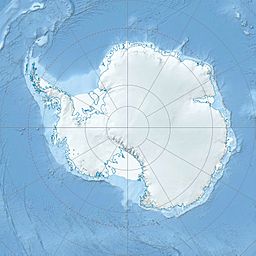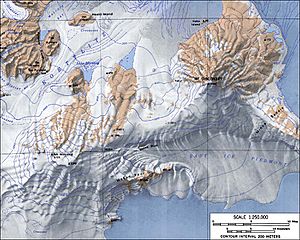Mount Morning facts for kids
Quick facts for kids Mount Morning |
|
|---|---|

Aerial view of Mount Morning from the northeast.
|
|
| Highest point | |
| Elevation | 2,725 m (8,940 ft) |
| Prominence | 1,515 m (4,970 ft) |
| Listing | Ultra |
| Geography | |
| Geology | |
| Mountain type | Shield volcano |
| Volcanic belt | McMurdo Volcanic Group |
| Last eruption | Unknown |
Mount Morning is a large, shield-shaped volcano in Antarctica. It's located in Victoria Land, near the Transantarctic Mountains. This volcano is about 100 kilometers (62 miles) from Ross Island. Mount Morning stands tall at 2,723 meters (8,934 feet) and is mostly covered in snow and ice.
At the top of the volcano is a wide caldera, which is a large bowl-shaped hollow. Several ice-free ridges, like Hurricane Ridge and Riviera Ridge, stretch out from the summit. You can also find many smaller parasitic vents, mostly cinder cones, scattered across the mountain.
Mount Morning first became active millions of years ago. It erupted in two main periods, with a quiet time in between. The older eruptions created rocks that look different and have been worn down by glaciers. The most recent small eruptions happened about 20,000 years ago. Scientists think Mount Morning could erupt again in the future.
Contents
Where is Mount Morning?
Mount Morning is found in Victoria Land, Antarctica. It sits at the base of the Transantarctic Mountains. The Koettlitz Glacier flows along the northwestern side of Mount Morning. This glacier separates the volcano from the Royal Society Range, which is about 25 kilometers (15.5 miles) away.
The volcano reaches 2,723 meters (8,934 feet) above sea level. Its top has a large caldera that is about 4.1 by 4.9 kilometers (2.5 by 3 miles) wide. Mount Morning is a huge shield volcano, roughly 30 by 36 kilometers (18.6 by 22.4 miles) in size. It has a main volcano built on top of an older volcanic area.
More than 185 smaller parasitic vents have formed on the sides of Mount Morning. These vents include cinder cones, long cracks that erupted lava, and lava domes. They range from a few meters to hundreds of meters wide. Many of these vents line up in patterns, often running from northeast to southwest. Lava flows from these cones cover the volcano's surface today.
What Does Mount Morning Look Like?
Mount Morning is almost completely covered by snow and ice. Only a few spots of volcanic rock stick out. These bare spots are found where strong winds from the south blow the snow away. You can see volcanic rocks on Riviera Ridge and Hurricane Ridge on the northern side. There are also outcrops on Mason Spur on the southern side and Helms Bluff on the eastern side.
Gandalf Ridge is a rocky point at the foot of Hurricane Ridge. Pinnacle Valley is another notable area on Riviera Ridge. In these exposed areas, you can find different types of volcanic features. These include dikes (cracks filled with magma), lava domes, lava flows, and pyroclastic deposits (ash and rock fragments). Mason Spur even has rocks formed from pillow lavas, which erupt underwater.
Because there isn't much flowing water, the volcano hasn't been worn down much. The smaller parasitic vents look very new. However, glaciers have eroded some parts of the volcano. They have left behind volcanic necks in Pinnacle Valley. Glaciers have also scratched marks into the rocks and left behind glacial till (rock and sediment).
The Vereyken Glacier flows down the northeastern slopes of Mount Morning. It runs between Hurricane Ridge and Riviera Ridge. Piles of rock and dirt called moraines are found on these ridges. Some moraines date back to the last Ice Age. Glaciers from Mount Morning also feed into the Koettlitz Glacier. Several lakes are found on and around the volcano, including Lake Morning at the end of Riviera Ridge.
How Mount Morning Formed
Mount Morning is part of a huge geological area called the West Antarctic Rift. This is one of the largest areas on Earth where the crust is pulling apart. This pulling apart causes volcanic activity.
The McMurdo Volcanic Group is a long chain of volcanoes in Victoria Land. Mount Morning is part of this group. These volcanoes have erupted a type of lava called alkaline lava for millions of years. Mount Morning is the southernmost volcano in the Erebus province, which is one of the three main parts of this volcanic group.
Mount Morning sits on top of much older rocks. These older rocks are called the Koettlitz Group. They include granite and other changed rocks, which can be seen near Gandalf Ridge.
What is Mount Morning Made Of?
The most common rock found at Mount Morning is called basanite. Other rocks like phonolite are less common, and picrobasalt and tephrite are rare. Older rocks found here include mugearite, rhyolite, and trachyte.
These volcanic rocks contain different types of phenocrysts, which are large crystals. Some of these crystals are olivine, feldspar, and quartz. The finer-grained material around these crystals, called the groundmass, also contains various minerals.
Sometimes, the volcanic rocks contain pieces of other rocks called xenoliths. These can be pieces of older rocks from Mount Morning or rocks from deep within the Earth, like syenite or peridotite.
The early lavas from Mount Morning are similar to rocks from Mount Melbourne. The newer lavas are more like those from Mount Erebus. Basaltic rocks are mostly found on the lower parts of the volcano. Phonolite is found higher up. The way the rock types changed over time might be due to changes in how magma moved through the crust.
When Did Mount Morning Erupt?
Mount Morning has been active over millions of years. It erupted during the Miocene, Pliocene, and Pleistocene periods. Scientists use special dating methods to figure out when these eruptions happened.
Rocks from Gandalf Ridge are about 18.7 to 15.5 million years old. Rocks from Pinnacle Valley are 15.2 to 13.0 million years old. Mason Spur has rocks from 12.8 to 11.4 million years ago. Some of these eruptions might have spread volcanic ash over the McMurdo Sound area.
The volcano's activity is divided into two main phases. The first phase happened between 18.7 and 11.4 million years ago. After a quiet period, the second phase began about 6.13 million years ago and continued almost to the present day. The rocks from the first phase are mildly alkaline, while the rocks from the second phase are strongly alkaline.
The older rocks have been greatly shaped by glaciers. The younger rocks, however, are mostly untouched and form the volcano we see today. Most eruptions happened in the open air. But some lavas might have erupted underwater, suggesting that glaciers were present 15.4 million years ago. Volcanic activity often followed existing cracks in the Earth's surface.
The most recent eruptions at Mount Morning occurred about 20,000 years ago. These eruptions formed the well-preserved cinder cones. In the 1960s, scientists noticed some heat coming from Gandalf Ridge. This suggested the volcano might still be active. However, later ground checks didn't find any fumaroles (steam vents). So, Mount Morning is considered a dormant volcano. It might be the source of ash layers found in the area.
How Mount Morning Got Its Name
The volcano was discovered by the Discovery Expedition between 1901 and 1904. It was named after the SY Morning, a ship that helped the expedition.
See also
 In Spanish: Monte Morning para niños
In Spanish: Monte Morning para niños



